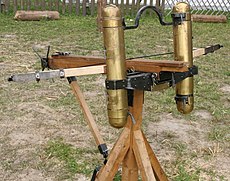Scorpio (weapon)
This article needs additional citations for verification. (October 2010) |

 |
| Part of a series on the |
| Military of ancient Rome |
|---|
|
|
The scorpio or scorpion was a type of Roman torsion siege engine and field artillery piece. It was described in detail by the early-imperial Roman architect and engineer Vitruvius[1] in the 1st century BC and by the 4th century AD officer and historian Ammianus Marcellinus.[2]
Design
Two versions are known: a horizontal two-armed variety like a ballista and a one-armed, vertical version otherwise referred to as an
Use
In 52 BC, during the siege of
The bolt-firing scorpio had mainly two functions in a legion. In precision shooting, it was a weapon of marksmanship capable of cutting down any foe within a distance of 100 m (330 ft). In parabolic shooting, the range is greater, with distances up to 400 m (1,300 ft), and the firing rate is higher (3 to 4 shots per minute). With precision shooting the rate of fire was significantly less. Scorpions could be used in an artillery battery at the top of a hill or other high ground, the side of which was protected by the main body of the legion. The weight and speed of a bolt was sufficient to pierce enemy shields, usually also wounding the enemy so struck.
Like other ancient artillery, the scorpion could be cumbersome and costly campaign equipment, as it could be quite difficult to move quickly and usually acted as a fixed weapon used in infantry defense and for sieges,[8] where it was used both as a siege weapon, fired by the besiegers from earthworks and siege towers, and as an element in cities' defences, mounted on walls and towers.
A further development of torsion siege engines scorpio was the cheiroballista.[9]
Media
-
Modern reconstruction
-
Scorpio in fortified position
-
Scorpio mounted on walls
-
Dacian scorpio
References
- ^ Vitruvius, De Architectura, X:10:1-6.
- ^ a b Ammianus Marcellinus, Roman History, XXIII:4.
- ISBN 978-1-134-63179-7.
- ISBN 978-1-4728-0831-8.
- ^ Julius Caesar, Commentarii de bello Gallico, VII:25
- ^ Gilliver, Kate (2002), Caesar's Gallic Wars, 58-50 BC (Series: Essential Histories); Osprey Publishing, pp 54-55.
- ^ Vegetius, De re militari, II, 25.
- ^ Cartwright, Mark (February 4, 2014). "Roman Artillery". World History Encyclopedia. Archived from the original on March 14, 2023.
- ISBN 0-8061-2794-5




